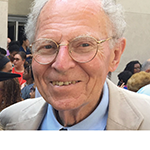
Dr. O’Shea, a physician and immunologist at the NIH for 33 years, has made fundamental discoveries related to cytokine signaling, molecular causes of primary immunodeficiencies and the genetic basis of autoinflammatory disorders. His work on Janus kinase (JAK) inhibitors through a Cooperative Research and Development Agreement with Pfizer resulted in a U.S. patent for a new class of immunosuppressive drugs, which includes tofacitinib. Tofacitinib has recently been approved by the FDA for the treatment of rheumatoid arthritis and is being studied for use in a number of other conditions.
Raphaela Goldbach-Mansky, MD, MHS, investigator and acting chief of the Translational Autoinflammatory Disease Section, has taken advantage of these developments, which have amplified her work characterizing immune dysregulation in pediatric patients with often monogenic autoinflammatory diseases. The ability to combine genetic and clinical studies at NIAMS has resulted in several translational examples “where we found a mutation and, based on that mutation, identified a treatment that we were then able to implement,” she says.
Example: She performed functional studies in patients with a rare disease, known as CANDLE, and found them unresponsive to interleukin 1 therapy, but she found a strong interferon signature. Positing that the inflammatory disease manifestations in these patients were driven by interferon, she wondered whether JAK inhibitors (which block interferon signaling, as well as inflammatory cytokines related to RA) might work. A compassionate use study for a small subset of patients showed that, indeed, the treatment was a viable option. The study has now been expanded to include another genetic disease, SAVI, tied to constitutive interferon-beta upregulation.
“This is translation at work,” Dr. Goldbach-Mansky says.
Training the Next Leaders
Traditionally, NIAMS (and its earlier iterations) has “been a major source of senior researchers in the country, through its fellowship and training programs,” notes Dr. Plotz. “The success of NIH has, in part, been due to people who left and became leaders across the country.” Freedom to pursue areas of interest without the burden of securing grant funding has been “a tremendous benefit,” he says. “The theory is, you hire the very smartest and best people you can and then leave them alone.”

Currently, the Rheumatology Fellowship Program accepts three new fellows each year, who participate in a three-year program, according to James D. Katz, MD, rheumatology fellowship program director. “The opportunity to marry teaching and research with clinical care is unparalleled anywhere else,” says Dr. Katz, who joined NIAMS in August 2013. “We want our trainees to graduate with the capability of becoming independent investigators running their own programs, and also be able to seamlessly integrate into an academic program if they choose. The advantage at NIAMS is that trainees are not burdened with billing and coding, and can devote themselves to a culture of discovery.”
